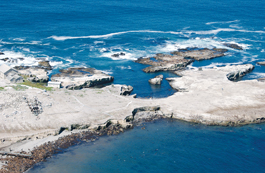home | metro santa cruz index | news | santa cruz | news article

Photograph by Kenneth & Gabrielle Adelman, California Coastal Records Project
Reserved: Marine protected areas, like the one at Ano Nuevo, limit fishing in order to protect marine ecosystem health. Some fishermen fear that without proper funding for the program, they'll be shut out of reserves indefinitely.
At Sea
Amid a state budget crisis, fishermen fear that marine protected areas will remain off-limits indefinitely.
By Alastair Bland
In 2007, 18 percent of the coastline between Pigeon Point and Point Conception was designated as "marine protected areas" by the Marine Life Protection Act, or MLPA. The objectives of the act, which former Assemblyman Fred Keeley co-authored and Gray Davis signed in 1999, include a long-term scientific monitoring program to determine how marine biodiversity reacts to curtailing of human disturbance in these protected zones.
But whether the state can supply the money to fully implement the MLPA remains a question. In December, Gov. Schwarzenegger put a freeze on monetary allotments for all bond-funded state operations, including the MLPA. In February, the governor signed the new budget, which can now be read online. It makes no mention of the MLPA.
Sandy Cooney, spokesman for the state's Natural Resources Agency, says that the document would be thousands of pages long if it had to list such details, and he assures that $4.6 million for the next fiscal year have been set aside for the MLPA's planning phase, which amounts to collecting baseline data, drawing lines on the map and establishing Marine Protected Areas.
The second phase--the implementation--will be the challenge, Cooney says. "How we'll fund the monitoring and enforcement of the marine protected areas is the question."
Bob Franko, chairman of the Coastside Fishing Club, doubts the state will be able to hire the wardens and biologists necessary to properly implement and protect the reserves.
"There's no money to carry out the MLPA, and without money there's no way to pay the biologists to study the reserves to see if they're working," he says.
Franko points to a fine-print clause in the MLPA that mandates "adaptive management" and which leaves open the possibility that some newly created marine reserves could eventually be reduced, enlarged, or even reopened again to recreational and commercial fishing--depending on the findings of subsequent assessments.
"But how will you have adaptive management without anyone out there managing?" says Franko.
Kaitilin Gaffney, director of Pacific Ecosystem Protection at Ocean Conservancy, has worked on implementing the Central Coast's MPA program since it was made law in 2007. She says $2 million in MLPA bond funding has largely been paid out already, and that the program is "poised for success."
"The frozen bond funds are a piece of the broader puzzle, but in no way are they threatening its success," she says. "The fact is, California's MPA program is better funded than any other MPA effort in the world. There are a lot of programs in the state that are under the chopping block right now, but this is just not one of them."
Where's the Money?
As the California Fish and Game Commission works at finalizing a network of marine protected areas on the coast from Pigeon Point north to Mendocino County and another network of reserves between Point Conception and Mexico--much of which work is being paid for by private environmental organizations--critics have suggested that the entire MLPA proceeding be halted until the state finds a guaranteed long-term source of funding. This is in part because MLPA's largest private benefactor--the Resources Legacy Fund Foundation--has said that it will withdraw its financial support for the MLPA once the planning phase is done.
"It's doubtful that our charity will be available indefinitely for the maintenance of what is essentially a state process," said Michael Valentine, an attorney providing oversight of the environmental advocacy organization's MLPA donations. "Once the network [of MPAs] is created and effective, we'll likely remove ourselves and let the state do everything it can to administer and monitor them."
And that is exactly what some fishermen, who hope to fish again in some of these waters, are afraid of. On the Central Coast, MPAs now occupy 204 square miles and include Natural Bridges State Marine Reserve and Ano Nuevo State Marine Conservation Area, and roughly a dozen others in Santa Cruz and Monterey counties. The new law calls for follow-up studies of these reserves sometime in 2012 or 2013--plus constant protection from poachers.
Assistant chief at the Department of Fish and Game Tony Warrington says approximately 18 wardens currently guard the entire coast between Santa Barbara and Santa Cruz. The new budget allows for 14.2 new warden positions statewide, but Warrington points out that the positions will not bear any specific marine emphasis.
Samantha Murray, Pacific Region Ecosystems manager with the Ocean Conservancy, believes that private and interagency support will save the day. According to Murray, representatives of the Monterey Bay Sanctuary Foundation, San Mateo County Parks, Point Reyes National Seashore and the Gulf of the Farallones National Marine Sanctuary have already expressed to the Fish and Game Commission their willingness to help with education, monitoring and--crucially--enforcement. Gaffney adds to that list the Bureau of Land Management, National Parks and California State Parks, adding up to what she calls "a level of support not often seen in other settings."
Though the cobbled-together funding isn't ideal, Murray doesn't feel that the current economic depression merits waiting around; California's marine ecosystems need boosted protection now.
"We have a huge tourism industry based on our ocean resources, and this isn't an issue that we can afford to wait on while the economy recovers. We have fisheries and ecosystems in decline."
Franko sees another outcome.
"They're just going to put up the no-trespassing signs and they'll stay there forever. The public will never get these waters back."
With additional reporting by Curtis Cartier and Traci Hukill.
Send a letter to the editor about this story.
|
|
|
|
|
|